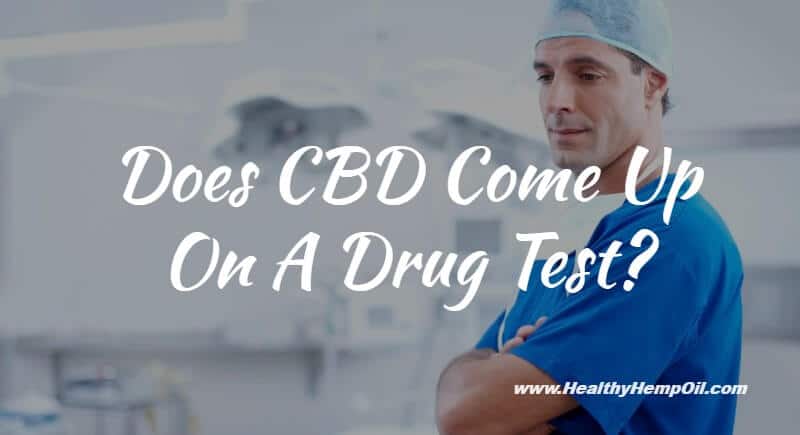Education
Does CBD Show Up On A Drug Test?
Does CBD Show Up On A Drug Test?
First things first, we need to examine what drug tests actually look for. Drug testing is a real problem that can plague people who use cannabis medicinally but who also need to have steady employment. So, does CBD show up on a drug test? Let’s find out.
As we’ve discussed before, even though our products contain next to no THC, this is not because THC does not have any potential benefit or that it is merely a dangerous and toxic substance. It’s just different, with a different chemical makeup and different effects compared to CBD supplements.
Many people out there might take THC, or the FDA-approved pharmaceutical known as Marinol, prescribed for appetite stimulation or nausea aid. Unfortunately for such people, employee drug tests often look for THC. According to Employee Drug Testing Ace,
“THC (?9-tetrahydrocannabinol) is the primary active ingredient in cannabis (Marijuana)… The peak effect of marijuana administered by smoking occurs in 20-30 minutes and the duration is 90-120 minutes after one cigarette. Elevated levels of urinary metabolites are found within hours of exposure and remain detectable for 3-10 days after smoking. The main metabolite excreted in the urine is 11-nor-?9-tetrahydrocannabinol-9-carboxylic acid (?9-THC-COOH).”
This is good news for CBD users. But let’s get into the technicalities. You might be rightly asking, “What if I take a whole lot of a CBD supplement that has trace amounts of THC? Does CBD come up on a drug test at that point?”
Well, firstly, no; CBD still won’t come up on the drug test because it is not what they are looking for. But if you take very high doses of a hemp oil product, THC might show up. According to Leafly, there are some key facts to be aware of:
- Employers almost always work according to the Substance Abuse and Mental Health Services Administration (SAMHSA) guidelines.
- There are two tests. An initial test sometimes yields false positives, but if it is positive in any event, another confirmatory test will take place.
- SAMHSA has the cutoff level for a positive THC urine screen at 50 ng/mL. (That’s 50 nanograms per milliliter.)
- If a positive is found in the initial test, a second test – gas chromatography and mass spectrometry – is performed, which only looks for the 11-nor-THCCOOH metabolite.
- This second test has a cutoff level at 15 ng/mL.
- “[H]emp contains anywhere from 1/10th to 1/300th of the THC concentration found in marijuana. An individual consuming 1000-2000 mg per day of hemp oil would thus consume approximately 3-6 mg of THC. This exceedingly high dose may result in detection of positive urine screen in up to 11% to 23% of assays.”
How Much THC is In Our Products?
Our products come from industrial hemp, and industrial hemp itself has about 0.3% THC concentrations or less. In fact, the U.S. often distinguishes “hemp” from “cannabis” based on these percentages, even though scientifically and botanically speaking, that’s not exactly accurate. Hemp is merely a type of cannabis but is known for being long and stalky and having next to no THC, often being used for its fiber. But a high-CBD strain of cannabis with 0.3% or less THC is seen as “hemp” in the government’s eyes, even if it doesn’t fit that taxa.
How Much is Legal?
Only products with 0.3% THC or less can be legally bought and sold and imported, according to Medical Jane.
THC in the Body
You might now be wondering just how much THC you could potentially safely ingest and how quickly it would pass through the body. Well, here’s an important tidbit found in an advisory from the CDC:
“Studies involving humans indicate that 80%-90% of the total dose of delta-9-THC is excreted within 5 days–approximately 20% in urine and 65% in feces (1). Plasma concentrations of delta-9-THC peak by the time a smoked dose is completed and usually fall to approximately 2 ng/ml within 4-6 hours. 9-carboxy-THC is detectable in plasma within minutes after a dose is smoked and remains in plasma considerably longer than THC itself. Urine from marijuana users contains quantities of 9-carboxy-THC in both free and conjugated form, as well as other cannabinoids (THC and its metabolites) detectable by the test.”
This means that, if you hypothetically ingest 6 mg of THC somehow, 1.2 mg (20%) of that is going to be excreted through the urine within 5 days. We were discussing nanograms earlier, so how many nanograms are in a milligram? The answer is 1,000,000.
Let’s do a little more math, shall we? If the cutoff level for the initial drug test is 50 nanograms, that means you can only have less than 0.00005 mg (convert nanograms to milligrams) present in a milliliter of your urine. But, given the fact that the normal range of urine output is 800 to 2,000 milliliters per day, if you have a normal fluid intake of about 2 liters per day, the figure for the amount of THC you could have in your urine for the five-day period ranges from 0.04 mg to 0.1 mg. And that would still only be 20% of what you ingested, meaning you could potentially ingest 0.2 mg to 0.5 mg of THC in a five-day period and still be just within the range of safe. That said, there are no guarantees for a negative or positive result.
To give you a broader understanding, if you have 200 mg of hemp oil, and 0.3% of that is THC, you will have consumed 0.6 mg of THC. But bear in mind, some hemp-derived products have even less than 0.3% concentrations. It all depends on the product and the brand itself.
In Conclusion
The most important take-away is to be aware of how much THC might be in your product. Our CBD supplements, in order to be legal, cannot have more than 0.3% of THC in them. But regarding other kinds of CBD oils on the market, you can investigate whether a product has come from hemp or from a pressed whole-plant cannabis extract. If it is the latter, you will need more information about the strain and how much THC is in that particular strain. Also, tests may not always be the same and results can vary.
- Be aware of how much THC, if any, is in your CBD supplements.
- Try not to have more than 180 mg of hemp oil daily if that hemp oil specifically has the maximum of 0.3% THC concentrations.
- Know that drug tests look for THC and its metabolites, not CBD.
- 20% of what you ingest will be present in your urine over the course of a five-day period.
- Be aware of the cutoff level 50 ng/mL for the initial drug test.
- Know that there are two screenings with the second being more diligent and accurate.
FDA Disclaimer: These statements have not been evaluated by the Food and Drug Administration. Products sold by Healthy Hemp Oil are not intended to diagnose, treat, cure, or prevent any disease. The information on our website is intended to provide general information regarding our products and is not to be construed as medical advice or instruction. Read more


I am on a pain management contract, I purchased hemp oil and my urine was positive for marijuana. Now I am in trouble with my doc and will receive no more pain medicine til my urine is ‘clean. WTH?